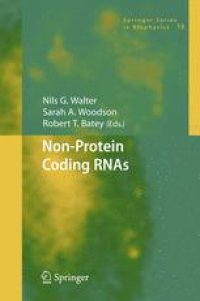
Ebook: Non-Protein Coding RNAs
- Tags: Biophysics/Biomedical Physics, Bioinformatics, Biochemistry general, Cell Biology, Molecular Medicine
- Series: Springer Series in Biophysics 13
- Year: 2009
- Publisher: Springer-Verlag Berlin Heidelberg
- Edition: 1
- Language: English
- pdf
This book assembles chapters from experts in the Biophysics of RNA to provide a broadly accessible snapshot of the current status of this rapidly expanding field. The 2006 Nobel Prize in Physiology or Medicine was awarded to the discoverers of RNA interference, highlighting just one example of a large number of non-protein coding RNAs. Because non-protein coding RNAs outnumber protein coding genes in mammals and other higher eukaryotes, it is now thought that the complexity of organisms is correlated with the fraction of their genome that encodes non-protein coding RNAs. Essential biological processes as diverse as cell differentiation, suppression of infecting viruses and parasitic transposons, higher-level organization of eukaryotic chromosomes, and gene expression itself are found to largely be directed by non-protein coding RNAs. The biophysical study of these RNAs employs X-ray crystallography, NMR, ensemble and single molecule fluorescence spectroscopy, optical tweezers, cryo-electron microscopy, and other quantitative tools. This emerging field has begun to unravel the molecular underpinnings of how RNAs fulfill their multitude of roles in sustaining cellular life. The physical and chemical understanding of RNA biology that results from biophysical studies is critical to our ability to harness RNAs for use in biotechnology and human therapy, a prospect that has recently spawned a multi-billion dollar industry.
This book assembles chapters from experts in the Biophysics of RNA to provide a broadly accessible snapshot of the current status of this rapidly expanding field. The 2006 Nobel Prize in Physiology or Medicine was awarded to the discoverers of RNA interference, highlighting just one example of a large number of non-protein coding RNAs. Because non-protein coding RNAs outnumber protein coding genes in mammals and other higher eukaryotes, it is now thought that the complexity of organisms is correlated with the fraction of their genome that encodes non-protein coding RNAs. Essential biological processes as diverse as cell differentiation, suppression of infecting viruses and parasitic transposons, higher-level organization of eukaryotic chromosomes, and gene expression itself are found to largely be directed by non-protein coding RNAs. The biophysical study of these RNAs employs X-ray crystallography, NMR, ensemble and single molecule fluorescence spectroscopy, optical tweezers, cryo-electron microscopy, and other quantitative tools. This emerging field has begun to unravel the molecular underpinnings of how RNAs fulfill their multitude of roles in sustaining cellular life. The physical and chemical understanding of RNA biology that results from biophysical studies is critical to our ability to harness RNAs for use in biotechnology and human therapy, a prospect that has recently spawned a multi-billion dollar industry.
This book assembles chapters from experts in the Biophysics of RNA to provide a broadly accessible snapshot of the current status of this rapidly expanding field. The 2006 Nobel Prize in Physiology or Medicine was awarded to the discoverers of RNA interference, highlighting just one example of a large number of non-protein coding RNAs. Because non-protein coding RNAs outnumber protein coding genes in mammals and other higher eukaryotes, it is now thought that the complexity of organisms is correlated with the fraction of their genome that encodes non-protein coding RNAs. Essential biological processes as diverse as cell differentiation, suppression of infecting viruses and parasitic transposons, higher-level organization of eukaryotic chromosomes, and gene expression itself are found to largely be directed by non-protein coding RNAs. The biophysical study of these RNAs employs X-ray crystallography, NMR, ensemble and single molecule fluorescence spectroscopy, optical tweezers, cryo-electron microscopy, and other quantitative tools. This emerging field has begun to unravel the molecular underpinnings of how RNAs fulfill their multitude of roles in sustaining cellular life. The physical and chemical understanding of RNA biology that results from biophysical studies is critical to our ability to harness RNAs for use in biotechnology and human therapy, a prospect that has recently spawned a multi-billion dollar industry.
Content:
Front Matter....Pages i-xi
RNA 3D Structural Motifs: Definition, Identification, Annotation, and Database Searching....Pages 1-26
Theory of RNA Folding: From Hairpins to Ribozymes....Pages 27-47
Thermodynamics and Kinetics of RNA Unfolding and Refolding....Pages 49-72
Ribozyme Catalysis of Phosphodiester Bond Isomerization: The Hammerhead RNA and Its Relatives....Pages 73-102
The Small Ribozymes: Common and Diverse Features Observed Through the FRET Lens....Pages 103-127
Structure and Mechanism of the glmS Ribozyme....Pages 129-143
Group I Ribozymes as a Paradigm for RNA Folding and Evolution....Pages 145-166
Group II Introns and Their Protein Collaborators....Pages 167-182
Understanding the Role of Metal Ions in RNA Folding and Function: Lessons from RNase P, a Ribonucleoprotein Enzyme....Pages 183-213
Beyond Crystallography: Investigating the Conformational Dynamics of the Purine Riboswitch....Pages 215-228
Ligand Binding and Conformational Changes in the Purine-Binding Riboswitch Aptamer Domains....Pages 229-247
The RNA–Protein Complexes of E. coli Hfq: Form and Function....Pages 249-271
Assembly of the Human Signal Recognition Particle....Pages 273-284
Forms and Functions of Telomerase RNA....Pages 285-301
Ribosomal Dynamics: Intrinsic Instability of a Molecular Machine....Pages 303-316
Biophysical Analyses of IRES RNAs from the Dicistroviridae: Linking Architecture to Function....Pages 317-333
Structure and Gene-Silencing Mechanisms of Small Noncoding RNAs....Pages 335-356
Back Matter....Pages 357-398
This book assembles chapters from experts in the Biophysics of RNA to provide a broadly accessible snapshot of the current status of this rapidly expanding field. The 2006 Nobel Prize in Physiology or Medicine was awarded to the discoverers of RNA interference, highlighting just one example of a large number of non-protein coding RNAs. Because non-protein coding RNAs outnumber protein coding genes in mammals and other higher eukaryotes, it is now thought that the complexity of organisms is correlated with the fraction of their genome that encodes non-protein coding RNAs. Essential biological processes as diverse as cell differentiation, suppression of infecting viruses and parasitic transposons, higher-level organization of eukaryotic chromosomes, and gene expression itself are found to largely be directed by non-protein coding RNAs. The biophysical study of these RNAs employs X-ray crystallography, NMR, ensemble and single molecule fluorescence spectroscopy, optical tweezers, cryo-electron microscopy, and other quantitative tools. This emerging field has begun to unravel the molecular underpinnings of how RNAs fulfill their multitude of roles in sustaining cellular life. The physical and chemical understanding of RNA biology that results from biophysical studies is critical to our ability to harness RNAs for use in biotechnology and human therapy, a prospect that has recently spawned a multi-billion dollar industry.
Content:
Front Matter....Pages i-xi
RNA 3D Structural Motifs: Definition, Identification, Annotation, and Database Searching....Pages 1-26
Theory of RNA Folding: From Hairpins to Ribozymes....Pages 27-47
Thermodynamics and Kinetics of RNA Unfolding and Refolding....Pages 49-72
Ribozyme Catalysis of Phosphodiester Bond Isomerization: The Hammerhead RNA and Its Relatives....Pages 73-102
The Small Ribozymes: Common and Diverse Features Observed Through the FRET Lens....Pages 103-127
Structure and Mechanism of the glmS Ribozyme....Pages 129-143
Group I Ribozymes as a Paradigm for RNA Folding and Evolution....Pages 145-166
Group II Introns and Their Protein Collaborators....Pages 167-182
Understanding the Role of Metal Ions in RNA Folding and Function: Lessons from RNase P, a Ribonucleoprotein Enzyme....Pages 183-213
Beyond Crystallography: Investigating the Conformational Dynamics of the Purine Riboswitch....Pages 215-228
Ligand Binding and Conformational Changes in the Purine-Binding Riboswitch Aptamer Domains....Pages 229-247
The RNA–Protein Complexes of E. coli Hfq: Form and Function....Pages 249-271
Assembly of the Human Signal Recognition Particle....Pages 273-284
Forms and Functions of Telomerase RNA....Pages 285-301
Ribosomal Dynamics: Intrinsic Instability of a Molecular Machine....Pages 303-316
Biophysical Analyses of IRES RNAs from the Dicistroviridae: Linking Architecture to Function....Pages 317-333
Structure and Gene-Silencing Mechanisms of Small Noncoding RNAs....Pages 335-356
Back Matter....Pages 357-398
....


















